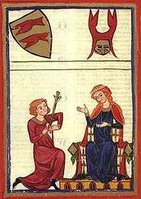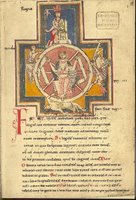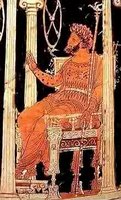At twenty-five Walchelin has already led a rich and interesting life, two decades and another half of living in
Why I like Ars Magica is that you also have the challenge of historical context to work with.
This is the first full draft and I am awaiting the Storyguides feedback and input.
Walchelin
Recently becoming a Redcap Walchelin had been a student of the Universitas Magistrorum et Scholarium in
As a member of the Normandy Nationes and a student within the Schools of Arts and Theology Walchelin was always rowdy and boisterous during his revelries, but at all times remained articulate, charming and passionate, especially towards his studies within the University; something he has carried with him into his Redcap duties. His time in
Events in
 In March 1229, on Shrove Tuesday,
In March 1229, on Shrove Tuesday,
Because students were exempt from the king's courts, angry complaints were filed with the Pope's courts. The Pope's courts knew that the University tended to be very protective of its students and they were trying to approach the matter carefully. But the secular ruler, Blanche of Castile, the ruler of
The strike and the results for Walchelin
Unfortunately the response from the University was immediately to go on strike. Classes were closed and striking students either went to other universities such as
The role of Euphêmía
On the night of the riot, during a break in his performance at Les Yeux d'Émeraude, Walchelin was befriended by a beautiful young woman by the name of Euphêmía. With her striking green eyes he was immediately attracted to her and he performed to the best of his abilities, attempting to engage her with a passionate performance. During the ensuing songs he performed the full spectrum of his repertoire, including a beautiful and original tale of Hades and Perspehone which referenced the unmatched work of Ovid – it was especially successful in the satirical targeting of Hades in-ability to control his stolen wife Persephone. The performance, ultimately unfortunately, attracted some unexpected attention from a quarter that Walchelin has yet to realize – Hades himself. Additionally the performance had a substantial impact on all of his audience who, rather than become friendly and happy towards each other became rather unfriendly, and extraordinarily passionate in their unfriendliness – not only those in the audience but Hades himself had quite an adverse reaction. Unknown to Walchelin a well-intentioned member of his audience had botched her intervention in the events of the night. During his performance the young woman he had met led a dance amongst a number of the crowd but unknown to her this dance had not only failed but gone completely awry having the reverse of her intention of friendliness amongst all who witnessed the performance, instead unfriendliness, leading ultimately to fisticuffs and bloodshed ensued over the following days.

But, the magnificent performance of the Troubadour Walchelin won the undying adoration of Euphêmía who proceeded to spend much time with the young Walchelin, arriving at all his performances and taking part in many dances with the crowd. Eventually she revealed her true form of a Nymph of Dance to Walchelin – who had already guessed – and she is accompanying him south to continue her dancing, carousing and enjoyment of Walchelin’s art. For his part Walchelin appreciates the beauty and dance of Euphêmía, he suspects that she enhances his Music through her performance, but little suspects that her dancing is Magical Folk Dancing that requires a human to perform in order for it to succeed in having any effect.
The Curse of Hades
 Unfortunately for Walchelin Hades took great umbrage at the young Troubadour’s performance and is biding his time to exact revenge. Hades plan is that when the Troubadour finds himself truly in love the Faerie God has decided that he will steal the object of the Troubadour’s affections away to Hades, as he has done with a number of young loves in the past, and then, at every opportunity, taunt the forlorn Minstrel with his powerlessness in the face of the Fae God of Hades.
Unfortunately for Walchelin Hades took great umbrage at the young Troubadour’s performance and is biding his time to exact revenge. Hades plan is that when the Troubadour finds himself truly in love the Faerie God has decided that he will steal the object of the Troubadour’s affections away to Hades, as he has done with a number of young loves in the past, and then, at every opportunity, taunt the forlorn Minstrel with his powerlessness in the face of the Fae God of Hades.
Walchelin prefers a style of playing and singing that consists of rich dialogue varied by refrains, the melodies to which have the character of folk music, and are spontaneous and tuneful but overlay elaborate and complex compositions that are harmonious. Normally he performs trobar ric, though increasingly he has become influenced by trobar leu and very rarely Walchelin plays the more restrictive trobar clus. When playing, two of his favourite genres are Descort and Tenso; though he finds the combination of challenge and foolishness that is Sestina driving him to attempt performances incorporating this genre. He prefers to play the Mandolin but is also skilled with other stringed instruments, as well as wind – such as the bag-pipes - and percussion – particularly the tabor.
Styles
Trobar leu
The trobar leu, or light style of poetry, was the most popular style used by the troubadours. Its accessibility gave it a wide audience.
Trobar ric
The trobar ric, or rich form of poetry, was distinguished by its verbal gymnastics; trobar ric has always played a secondary role to trobar leu.
Trobar clus
Trobar clus, or closed form, was the style of poetry used by troubadours for their more discerning audiences, and it was only truly appreciated by an elite few. It was developed extensively by Marcabru, but by 1200 its inaccessibility led to its disappearance.
Genres
 The poetry of the troubadour songs covered many topics, from the profound to the humorous and from war at home to the crusades. However, they are best known for expounding on the theme of fin' amors, or courtly love.
The poetry of the troubadour songs covered many topics, from the profound to the humorous and from war at home to the crusades. However, they are best known for expounding on the theme of fin' amors, or courtly love.
· Alba: The Alba is a song of the morning, used by the troubadours. It concerns the departure of a lover in the early morning. This style of song was later developed by the German minnesingers who called it a tagelied.
· Coblas: probably composed of several strophe, each a pair of stanza of alternating form on which the structure of the poem or song is based. Though a Coblas is also described as a band. Maybe everyone in the band plays different strophe.
· Descort: The Descort is a song of disagreement used by the troubadours. The subject matter is one of disagreement and this is emphasised by unusual metric structures and irregular rhymes.
· Devinaill: No clue on what this Genre is about.
· Estampida: The Estampida is the Occitan equivalent of the French estampie. According to Grocheo in his book De Musica the estampie is a melody without words with a complicated melodic progression. This does not seem to have been a universally accepted definition however, as the song Kalenda maia by Raimbaut de Vaquerais describes itself as an estampida.
· Pastorela: The Pastorela is a poetic genre used by the troubadours, which was the genesis of the pastourelle. It concerns the meeting of a knight with a shepherdess, which may lead to any of a number of possible conclusions. They are usually humorous pieces.
· Planh: The Planh is a funeral lament used by the troubadours, modeled on the Medieval Latin planctus. It differed from the planctus in that it was intended for a secular audience.
· Retroencha: based on some references probably classical song of praise, though I am not sure.
· Sestina: Of all the poetic forms created in the Middle Ages, the sestina is perhaps the silliest. It was almost certainly invented by the troubadour Arnot Daniel who had the good sense to only write one. The sestina is created using six key words, and has six stanzas of six lines each with a concluding three line stanza at the end. The six key words appear at the end of one line each in the first stanza, and we shall call the order they occur in 1, 2, 3, 4, 5, 6. In the second stanza each line again is concluded with a key word, this time in order 6, 1, 5, 2, 4, 3. In the third stanza the words are shuffled the same way, so that the order is 3, 6, 4, 1, 2, 5. This continues until six stanzas have been completed. The six words are then used in the concluding three line stanza, with two key words per line.
· Sirventes: The Sirventes is a form of poetry utilised by the troubadours. It was a song written in the style of a canso, addressing current events from the perspective of a sirven, a paid soldier. It was always partisan, being either highly complimentary or oozing with vitriol. The most famous exponent of the sirventes was Bertran de Born.
· Tenso: A Tenso is a song style favoured by the troubadours. It takes the form of a debate in which each voice defends a position on a topic relating to love or ethics.





No comments:
Post a Comment